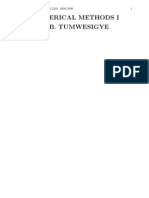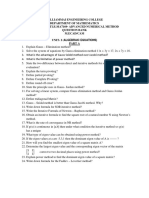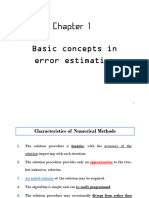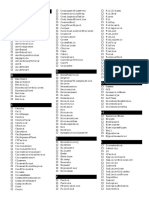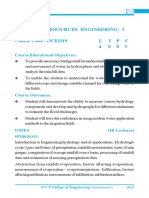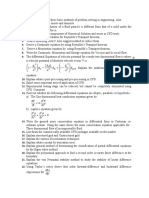Numerical Analysis Assignment
Uploaded by
Dipankar NathNumerical Analysis Assignment
Uploaded by
Dipankar NathAssignment – 7
(Numerical Analysis)
Q.1. Find the missing values in the following table:
x: 0 1 2 3 4 5 6 7
y: 1 -1 1 -1 1 --- --- ---
Q.2. Using Newton’s forward and backward formula, find the value of f (0.7) , if
x: 0.1 0.2 0.3 0.4 0.5 0.6
f(x) : 2.68 3.04 3.38 3.68 3.96 4.21
Q.3. State Newton’s forward and backward interpolation formula and use these to calculate
the value of f (1.85) , given the following
x: 1.7 1.8 1.9 2.0 2.1 2.2 2.3
f(x) : 5.474 6.050 6.686 7.389 8.166 9.025 9.974
Q.4. Find the first and tenth terms of the series if the following data are given
x: 3 4 5 6 7 8 9
y: 2.7 6.4 12.5 21.6 34.3 51.2 72.9
Q.4. Find the real root of the equation 3 x cos( x ) 1 by Newton-Raphson method.
Q.5. Find the fourth root of 12 correct to four decimal places using the Newton’s method.
Q.6. Find a root of the following equations correct to three significant figures using Newton’s
iterative method:
(i) x 4 12 x 7 0 (ii) x 5 5 x 2 3 0 (iii) x sin( x ) cos( x) 0 which is near x
(iv) x e x 2 0 (v) x 4 x 3 7 x 2 x 5 0 lying between 2 and 3.
Q.7. Employ Picard’s method to obtain correct to four places of decimal, solution for the
differential equation dy / dx x 2 y 2 for x 0.4 , given that y 0 when x 0 .
Q.8. Using Picard’s approximation, obtain a solution upto the fifth approximation of the
dy x2
equation , y (0) 0 .
dx y 2 1
Q.9. Using Taylor’s series method, compute the value of y at x 0.1 and x 0.2 upto five
places of decimals from dy / dx x 2 y 1 , y (0) 1 .
Q.10. Evaluate y(0.1) correct to four places of decimals from dy / dx y 2 x , y (0) 1 by
the Taylor’s series method.
Q.11. Apply Runge-Kutta fourth order method, to find an approximate value of y when
x 0.2 given that dy / dx x y , y (0) 1 .
dy y 2 x 2
Q.12. Using Runge-Kutta fourth order method, solve , y (0) 1 at x 0.2 , 0.4 .
dx y 2 x 2
You might also like
- (Book) Bertsimas, D. & Tsitsiklis, J. N. 19yy Introduction To Linear Optimization - Athena Scientific0% (2)(Book) Bertsimas, D. & Tsitsiklis, J. N. 19yy Introduction To Linear Optimization - Athena Scientific186 pages
- Chapter 02 (Solution of Algebraic & Transcendental Equation)100% (1)Chapter 02 (Solution of Algebraic & Transcendental Equation)24 pages
- Solution of Algebric & Transcendental EquationsNo ratings yetSolution of Algebric & Transcendental Equations22 pages
- (MADHU MANGAL PAUL) Numerical Analysis For Scienti100% (1)(MADHU MANGAL PAUL) Numerical Analysis For Scienti666 pages
- Unit4 NumericalMethods (MCS MES MCV MME)No ratings yetUnit4 NumericalMethods (MCS MES MCV MME)10 pages
- Numerical Approximation of Poisson Equation Using The Finite Difference MethodNo ratings yetNumerical Approximation of Poisson Equation Using The Finite Difference Method8 pages
- Worked Out Examples and Exercises With Solutions Chapter 17 PDF100% (1)Worked Out Examples and Exercises With Solutions Chapter 17 PDF11 pages
- Dca2101 - Computer Oriented Numerical MethodsNo ratings yetDca2101 - Computer Oriented Numerical Methods9 pages
- MC0074 - Statistical and Numerical Methods Using C++No ratings yetMC0074 - Statistical and Numerical Methods Using C++14 pages
- CH-1 Differential Calculus of Functions of Several VariablesNo ratings yetCH-1 Differential Calculus of Functions of Several Variables21 pages
- Linear Algebra - Solved Assignments - Fall 2005 Semester100% (1)Linear Algebra - Solved Assignments - Fall 2005 Semester28 pages
- Linear Equations in 2 Variables Worksheet 3No ratings yetLinear Equations in 2 Variables Worksheet 31 page
- A. Approximations: 1. The Linear Approximation LinearizationsNo ratings yetA. Approximations: 1. The Linear Approximation Linearizations7 pages
- Chapter # 2 Solution of Algebraic and Transcendental Equations100% (2)Chapter # 2 Solution of Algebraic and Transcendental Equations31 pages
- Chapter 1 Basic Concepts of Error EstimationNo ratings yetChapter 1 Basic Concepts of Error Estimation23 pages
- Solution of Difference Equations Using The ZNo ratings yetSolution of Difference Equations Using The Z2 pages
- 4.2 Regula-Falsi Method or Method of False PositionNo ratings yet4.2 Regula-Falsi Method or Method of False Position15 pages
- Some Notes On Least Squares, QR-factorization, SVD and FittingNo ratings yetSome Notes On Least Squares, QR-factorization, SVD and Fitting12 pages
- Symbolic Math Toolbox: Quick Reference Sheet: Algebra CalculusNo ratings yetSymbolic Math Toolbox: Quick Reference Sheet: Algebra Calculus2 pages
- 4.4.3 Geometrical Significance of Newton-Raphson Method: X F X XNo ratings yet4.4.3 Geometrical Significance of Newton-Raphson Method: X F X X6 pages
- Design of Truss-Bridge: Bachelor of Technology, 4th Semester Mini ProjectNo ratings yetDesign of Truss-Bridge: Bachelor of Technology, 4th Semester Mini Project17 pages
- Simulation of Fluid Sloshing in A Tank: June 2010No ratings yetSimulation of Fluid Sloshing in A Tank: June 20107 pages
- Name: Kandlakuti Vasanth Kumar: SC Id: 1811042No ratings yetName: Kandlakuti Vasanth Kumar: SC Id: 18110426 pages
- To, General Manager (CONSTRUCTION) North East Frontier Railways (Indian Railway) Maligaon, Guwahati-781011, AssamNo ratings yetTo, General Manager (CONSTRUCTION) North East Frontier Railways (Indian Railway) Maligaon, Guwahati-781011, Assam2 pages
- Exercise Book - 08 - Miscellaneous Topics (Ddpanda)No ratings yetExercise Book - 08 - Miscellaneous Topics (Ddpanda)4 pages
- Modal Modelling of The Nonlinear Resonant Fluid SLNo ratings yetModal Modelling of The Nonlinear Resonant Fluid SL29 pages
- Dana Mackey (DIT) : Numerical Methods IINo ratings yetDana Mackey (DIT) : Numerical Methods II30 pages
- Strategic Intervention Material 20231105 141613 0000No ratings yetStrategic Intervention Material 20231105 141613 000025 pages
- FEM Lecture Notes by Peter Hunter, Andrew PullianNo ratings yetFEM Lecture Notes by Peter Hunter, Andrew Pullian153 pages
- Final Exam Answer of Numerical Methods 2019 PDFNo ratings yetFinal Exam Answer of Numerical Methods 2019 PDF6 pages
- Calculus 2 - MTHG003 - Lecture Notes (5) - Spring 2024 - Dr. Fayad GalalNo ratings yetCalculus 2 - MTHG003 - Lecture Notes (5) - Spring 2024 - Dr. Fayad Galal35 pages
- Single Choice Type (+2, 1) : STUDENT NAME: - Quadratic EquationsNo ratings yetSingle Choice Type (+2, 1) : STUDENT NAME: - Quadratic Equations1 page
- Class 10 Maths NCERT Solutions Chapter 2 Polynomials - Learn CBSENo ratings yetClass 10 Maths NCERT Solutions Chapter 2 Polynomials - Learn CBSE21 pages
- Chapter 6 Influence Lines For Statically Indeterminant PDFNo ratings yetChapter 6 Influence Lines For Statically Indeterminant PDF31 pages
- Closed-Form Solution of Beam On Pasternak Foundation Under Inclined Dynamic LoadNo ratings yetClosed-Form Solution of Beam On Pasternak Foundation Under Inclined Dynamic Load12 pages
- Linear Programming: The Simplex Method: Learning ObjectivesNo ratings yetLinear Programming: The Simplex Method: Learning Objectives50 pages
- Errors and Approximations Lec. 2.1: Errors in Numerical MethodsNo ratings yetErrors and Approximations Lec. 2.1: Errors in Numerical Methods13 pages
- Definition and Graph of Quadratic FunctionsNo ratings yetDefinition and Graph of Quadratic Functions23 pages
- Convergence of Interpolatory Polynomial Between Lagrange and HermiteNo ratings yetConvergence of Interpolatory Polynomial Between Lagrange and Hermite7 pages
















